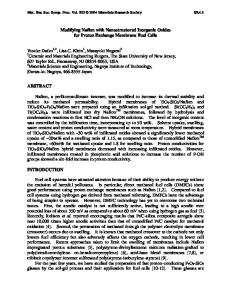Synthesis and characterization of novel functionalized perarylated polysiloxane for proton exchange membrane fuel cells
- PDF / 1,390,597 Bytes
- 7 Pages / 432 x 648 pts Page_size
- 6 Downloads / 342 Views
MRS Advances © 2019 Materials Research Society DOI: 10.1557/adv.2019.419
Synthesis and characterization of novel functionalized perarylated polysiloxane for proton exchange membrane fuel cells Guillermo M. González Guerra1, Alejandro Alatorre-Ordaz1, Gerardo González Garcia2, Jesus S. Jaime-Ferrer3 1 Universidad de Guanajuato. Depto. de Química. Cerro de la Venada s/n, Pueblito de Rocha. C.P. 36040, Guanajuato, México.
2 Universidad de Guanajuato. Depto. de Química. Noria Alta s/n, Noria Alta. C.P. 36050, Guanajuato, México.
3 CIATEC, AC, Omega no. 201 Col. Industrial Delta, C.P. 37545 León, Gto.
ABSTRACT
This work presents the synthesis and characterization of a pearylated polysiloxane material (PAP) from a polycondensation reaction, followed by functionalization with HClSO3 by an electrophilic substitution reaction. According to the characterization techniques applied, a sulfonated pearylated polysiloxane was also obtained, (SPAP). The purpose of this sulfonated material is to obtain an ionomer able to be applied in hydrogen fuel cells of the proton exchange membrane kind (PEMFC). The reaction to produce the polysiloxane precursor was carried out with the commercial reagents: PhSiCl3, Ph2SiCl2 and Ph3SiCl in anhydrous THF at 75 °C and the SPAP material was obtained by sulfonation of the precursor with chlorosulfonic acid. PAP and SPAP were characterized by 1H, NMR for liquids, 29Si NMR for solids, IR-ATR, SEM, and cyclic voltammetry. The NMR 29Si spectra show that PAP and PAPS contain crosslinking regions due to PhSiCl3, growing chain zones due to Ph2SiCl2 and polymer termination zones due to Ph3SiCl, obtaining a mixture of siloxanes. The analysis by cyclic voltammetry indicates that by integrating the area under the curve of the adsorption peaks of H2, a value of 0.062 mC/cm2 is obtained, a value close to the commercial ionomer of Nafion®.
Downloaded from https://www.cambridge.org/core. Columbia University Libraries, on 20 Jan 2020 at 11:46:06, subject to the Cambridge Core terms of use, available at https://www.cambridge.org/core/terms. https://doi.org/10.1557/adv.2019.419
INTRODUCTION Polysiloxanes are hybrid polymers that can be combined with organic functional groups to produce new organic-inorganic hybrid polymers with very interesting physicochemical properties, that make them attractive in different fields of science, and also for commercial applications [1-5]. The most important structural element in polysiloxane-based hybrid polymers is the Si-O bond, which provides a considerable thermal stability compared to purely organic polymers [6]; This bond is also the basis for the high flexibility that this kind of organic structures combined with polysiloxanes generally present [7,8]; this extraordinary flexibility can be explained by the length of the Si-O bond (1.64 Å), which is considerably longer compared to the C-C bond in organic polymers (1.53 Å). Consequently, the steric hindrance when combining functional groups with siloxanes decreases, since the Si-O-Si bond angle is approximately 143 and t
Data Loading...











